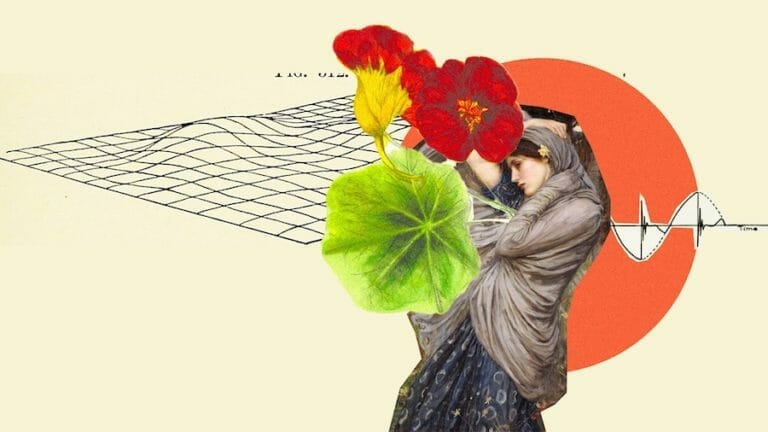Clarity on tantra and Western misconceptions
I’ll just briefly address what tantra is, because it’s a pretty huge topic. Essentially tantra, which in Sanskrit literally means ‘the system’ or a system of practice, was a spiritual movement that arose in north India around the year 500, or a little bit earlier, but it really appeared in a substantial way around the year 500. It grew in popularity until, as a spiritual movement, it was very widespread, indeed. Not so much numerically, not to say it was a popular movement per se, because tantra was always reserved for very committed, dedicated spiritual practitioners. It’s what we call an initiatory tradition. Anyone could be initiated regardless of caste, class, gender, social background, et cetera. To be initiated though, you had to sort of demonstrate to a guru, or teacher that your longing for doing deep spiritual practice was genuine.
So, they tried to sort of keep the ranks of the initiated to those people who were really committed to a daily spiritual practice. In that sense, it was numerically not all that huge, but had a massive influence on not only the culture of south Asia and Asia generally, but also even art and aesthetics. So, by the time of the peak of tantra, which was about the year 1000, it existed in many different forms. Not only in India, but also in what is now Pakistan, Nepal, Tibet, Bhutan, Southeast Asia, Indonesia, China and Japan—a very large cultural area—most of Asia, in fact, except for west Asia. The thing is the spiritual movement went by many names depending on the given group of practitioners, but we call it tantra after the names of the scriptures, because nearly all the scriptures, or kind of revealed wisdom works of this tradition, were referred to as tantras. Tantra can just mean a book or a text, but it specifically means a text teaching, a system of spiritual practice.

So, there were, at one time, about a thousand tantras, or texts, written in Sanskrit language and these scriptures, as I said, went by the name of tantra, meaning that was the suffix that was used. So, for example, there was the nature of tantras, Wichantra tantra, and many others. Most of these were lost in the period of the Muslim invasion and subsequent Muslim rule. We have around 200 tantric scriptures out of over a thousand that once existed. There are Buddhist tantras, Shiva tantras, Vishwa tantras; meaning to say, since it was a spiritual movement, it came to exist in different instantiations in all the religions of Asia. So therefore, scholars of tantra speak of Buddhist tantra and Shaiva tantra, where Shaiva means the religion of Shiva and Shakti, or means the tradition of Vishnu or Krishna. And obviously everyone knows what Buddhist means.
Tantra origins
Initially tantra began within the religion of Shaivism, the Shiva Shakti religion, and then spread from there to all the other religions that existed in Asia at the time. So, tantra is primarily a system of practice, more than a system of philosophy. Buddhism, and these other religions as well, like Jainism, were able to borrow tantric practice from Shaivism and sort of re-cast it in the mold of whatever the religion was. So, we could say tantra is a way of doing spirituality and therefore it existed in all these different forms. The tantric practices were actually very similar from Shaivism to Buddhism, to Vishwaism, but they existed in different philosophical contexts.
The quickest way to correct the misunderstanding about tantra is just to point out that Tibetan Buddhism, which is now famous these days, is tantra. All Tibetan Buddhism is tantric Buddhism, but they don’t always use that word because of the misunderstandings around it. Within the community of Tibetan Buddhism, they do use the word tantra quite frequently.

The Dalai Lama, for example, he is a tantrica, he is a practitioner of tantra. Although of course that’s not what he teaches on the world stage. And, because tantric teachings are reserved for initiates traditionally, he comes from a tantric world to view, but in general, and to the public, doesn’t teach specific tantric practices. That is, unless you take an initiation. And now of course, many hundreds of thousands of people have taken the chaal chakra initiation with the Dalai Lama or his representatives. And they do receive some tantric practices as a result of that.
So, the form of tantra that I study and practice is the Shiva Shakti form, which again, is the original form. It just happens to be the version of the tradition I most resonate with. And that’s what my book is about, _Tantra Illuminated_. I wrote that book, or it got written through me, I might say, because there really was no book that existed in English that was a thorough introduction to Shiva tantra. So, that’s an overview of the whole tradition. But because tantra practice is so similar in Buddhist forms, even though I wrote my book about Shaiva tantra, much of it is applicable to Buddhist tantra as well.
Synthesizing the purpose of tantra and yoga practices
Tantra is a complete spiritual path and it overlaps quite a lot with yoga. So, if we understand that the south Asian spiritual tradition could be mapped only in terms of overlapping circuits, then we can understand that tantra and yoga have a very substantial overlap. There are aspects of tantra, which are not yoga and there are aspects of yoga that are not tantric, but still a very substantial overlap. And indeed, tantra influenced the development of yoga tremendously. By yoga here, I don’t mean the physical postures that are famous today. I mean meditative spiritual practice, or what we might call inner yoga—the word yoga used to mean almost exclusively inner yoga, awareness, cultivation, meditative practices—a very internal thing. There are tantric rituals, but anyone doing tantric yoga, you wouldn’t be able to tell by looking at them as it’s very much an internal process of awareness cultivation.

Like other forms of yoga, it’s a fairly comprehensive sort of investigation of the inner world and to bring about substantial shifts in consciousness, whereby the goal is not so much to attain a kind of so-called higher state of consciousness that is somehow better than all other human beings. The goal is rather to deconstruct one’s social and cultural conditioning in order to be in a state of communion with naked reality, one might say. The goal of tantra is intimacy with reality, where reality is defined as whatever is happening before you have a thought about it, before you have an interpretation of it. That’s just a simple way to try and define what we mean here by the word reality with a capital R, we mean the direct experience prior to mental interpretation.
Aspects of reality
Now, that sounds very simple except for the fact that almost everybody comes up with interpretations of the nature of reality, and of themselves, more or less subconsciously. Meaning to say, social and cultural conditioning is so deep that our mind comes up with an interpretation of whatever’s happening by itself, almost automatically. So, it actually takes quite a bit of spiritual work to kind of deconstruct that process.
Seamless unity
There’s a kind of argument in the tradition, or a proposition, that if you can experience reality directly instead of through the lens of the conditioned mind, then you will see it as it truly is. And, as it turns out to be quite different from how you think it is. For example, the most basic example would be that most people perceive reality dualistically in terms of me versus you. There’s an aspect of reality I’ll call me, and there are other aspects I call not me. So, tantra argues that this is a conditioned mental construct that it’s only in the mind; that we draw these boundaries and say, “This is me, this is not me.” When in reality, what is, is one.
Seamless unity is the truth of reality, and knowing that as a concept is more or less useless. It’s not the point to hold a philosophical view, “Everything is one.” That doesn’t necessarily change your life, your day to day, moment to moment experience. The spiritual process of tantric yoga is to actually bring about in a very powerful, visceral way, the direct experience of oneness. Not just that, that’s just one major aspect of reality. The fact that it’s not two or many, but actually seamless unity.
All is one
Another aspect of reality that this tradition articulates is that not only is everything one, everything is consciousness. Meaning to say, nothing exists external to consciousness. Everything, absolutely all phenomena are internal to consciousness. Everything that you perceive, everything that you can think, taste, smell, touch, etc. are all just forms of consciousness. Nothing else exists but consciousness in its many different forms. So, the argument here is that if you deconstruct your conditioning, then that becomes obvious. Then that becomes a direct experience. That you experience everything as consciousness and everything as one consciousness.

The tools of identity
Everything is experienced as a vibration within consciousness. Now we call these vibrations by different names, such as sound, visual image, feeling, emotion, and thought. But in fact, those are just for convenience. You know, once you realize the truth, you only use those words for convenience, because they’re all just different sorts of frequencies of a vibration of the one consciousness. And there isn’t really a kind of difference. Everything is a vibration within awareness, within consciousness, the way in which the mind perceives analytically—carving reality up into discrete chunks—that turns out to be not true. It’s just a convenient way of talking about things that we take so seriously, that is how we perceive reality, right?
The implications of this are huge on literally every level environmentally, socially, politically, right? Because in this realization, there’s no more us vs. them. You realize that everything that people argue about is a mental construct. Being an American is a mental construct. Being an Israeli, a Palestinian, a Muslim, a Shia Muslim, or a Sunni Muslim, these are all fabricated. Meaning to say, human minds came up with these categories of thought and then they attach to these categories of thoughts so intensely that they’re willing to kill other people who think differently on the basis of nothing but a mental construct.
In the tantric tradition, the ego is nothing but the collected series of all your self images, it’s a raft of self-images, and the tradition argues you don’t need the ego, [these] defined interrelated self-images, to function effectively in the world. You just think you do because the ego sort of justifies its own existence. We get very attached to these forms of identity: I am an American, I’m a Christian, I’m a Muslim, I’m a man, I’m a woman; tantra teaches that those too are cultural categories, cultural constructs.
It’s actually quite a post-modern thing that was articulated over a thousand years ago. It’s quite amazing, really. In India it was kind of outrageous to say, caste is nothing but a social construct, it’s a cultural construct, it doesn’t exist in reality. So, what we realized through this process is that thoughts, all thoughts, are at best tools, and never truths.
